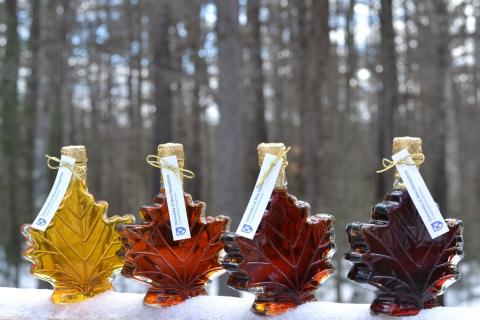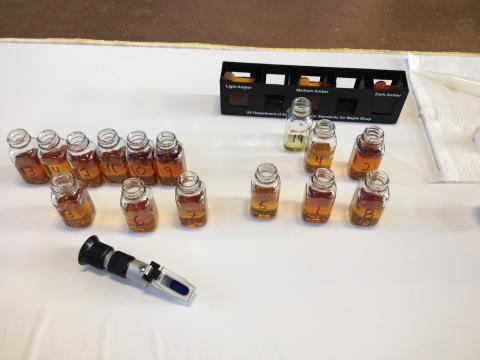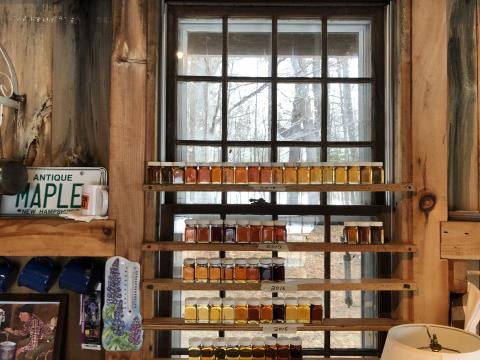Making the Grade—The Color and Flavor of Maple Syrup

Maple syrup is bottled in all sorts of containers with unique shapes, sizes, personalized labels and creative designs. Despite the variation on the outside, the syrup inside can only be one of four grades—Golden, Amber, Dark or Very Dark.
Maple grades are made of two components, color and flavor, and the flavor corresponds with the color. The darker the syrup, the stronger the maple flavor. For a syrup to make the grade, it must fall within the color range for that grade and have the proper flavor to match. Golden syrup must be light in color and have delicate flavor of maple. In cases where the flavor and color don’t match, the grade goes to the flavor or color that is darkest or strongest. For example, a syrup that has Golden color but a Dark flavor can’t be labeled as Golden, rather it is labeled as the Dark.
Since 2015, maple producers across North America grade syrup based on the Standards for Grades of Maple Syrup. Prior to 2015, each state and province had their own grading system. Today’s Golden syrup would have been graded as Fancy in Vermont, Grade A Light Amber in New Hampshire or Canada No. 1 Light Amber in Quebec. The 2015 standards provide a description of colors and flavors for each grade.
Maple Grades Explained
Golden—delicate flavor and lightest color
This is the lightest color and is usually associated with the first sap flows during the sugaring season. It is golden in color and with a subtle maple flavor, often with hints of vanilla. The delicate flavor often surprises people who expect a strong maple flavor found in other grades.
Amber—rich flavor and light amber color
Amber is slightly darker than Golden with a light amber color. The rich flavor is “a full-bodied maple taste of medium intensity.” This is the typical grade for folks looking for a classic maple syrup taste.
Dark—robust flavor and dark amber color
The robust flavor is more pronounced than Amber syrup and the subtle flavors found in Golden and Amber are often masked by the maple flavor. Folks who desire a more intense maple flavor formerly associated with the old NH Grade A Dark choose this grade.
Very Dark—strong flavor and darkest color
This grade is the darkest of all the grades and has a very intense maple flavor. In recent years, the Very Dark and Dark are preferred grades because consumers like the strong flavors of maple associated with these grades. Very Dark syrup holds up well in cooking and the maple flavor transfers to the final product.

How maple syrup color and flavor develop
Despite the wide range in color and flavor, all four grades are produced the same way—by boiling the sap until enough water has evaporated to reach maple syrup’s correct density of 66.9oBrix at room temperature. When the boiling sap reaches this density, it’s considered syrup. This usually happens around a boiling temperature of 219 to 220 oF. So how does the same production process yield this wide range or color and flavor in syrup throughout the season? It all has to do with the condition of the sap.
Color
The coloring of syrup is affected by several factors and each factor can influence another—it gets complex. The pH of the boiling sap, sugar concentration, types of sugars in the sap, length of boiling time to produce syrup, the temperature outside, and even microbial activity all play a role in syrup color.
The most common form of sugar in sap is sucrose –a complex, stable form of sugar. Once the sap is outside the tree the sucrose molecules are exposed to naturally occurring bacteria and yeast that break down sucrose sugars into simpler fructose and glucose sugars. The warmer the air and sap temperature, the more active the microbes, the more sucrose that gets converted. These converted sugars can go through a Maillard reaction or “browning” process while sucrose doesn’t. The bacteria and yeasts are killed during the boiling process.
Maillard reactions are the same reactions that browns the crust of baked bread or gives French fries that golden color. They also provide the coloring for maple syrup. The more glucose and fructose sugars in the boiling sap and the longer the sap boils, the darker the syrup will be. Sap with lower pH also breaks down sucrose, resulting in more glucose and fructose. Furthermore, the concentration of sugar in sap influences boiling time. The higher the sugar content, the shorter the boiling time. When the sap is exposed for less time in the evaporator, there is less time for browning resulting in a lighter grade of syrup.
In short, Golden syrup, in part, is a product of sap that has had little microbial activity either because of lower temperatures and/or sanitary sap handling. It’s quite common for sugarmakers to clean their equipment often throughout the season to keep the syrup from getting darker. It’s also common for them to be happy if there is a good cold snap in the weather forecast late March. The frigid nights can lighten up the syrup. Likewise, as the season goes on, temperatures build, sugar content in the sap declines, microbial activity increase, and the syrup color darkens.

Flavor
Preference for a flavor comes down to personal taste. One may not like the flavor of Golden syrup but that is the appropriate flavor for the grade. Most folks enjoy the Dark and Very Dark grades of syrup due to the robust and strong maple flavors. Those grades tend to be produced later in the season when it takes longer to make syrup due to lower sugar contents. This longer boiling allows for more flavor to develop and Maillard reactions play a role. Not only is color developed during these reactions, so is flavor. The flavors found in Golden and Amber syrups have some developed maple flavors but are mild in comparison because the boil time is less, and sucrose levels are higher. The mild and delicate maple flavors allow for other organic substances found naturally in maple sap to be part of the flavor profile. Besides boiling time and sap composition, soils, tree-health, sap handling and processing, and weather can affect flavor development and give unique flavors to every sugarhouse.
Despite the complex processes and unknowns producing the colors and flavors of maple syrup, one fact is certain—there is a grade of maple syrup out there for you. Plan a trip with some friends and family and visit New Hampshire sugarhouses to sample the different grades of syrup and discover the wide range of flavors hidden in those maple containers. You can impress everyone with your knowledge of Maillard reaction.
Steve Roberge is the Cheshire County Forester and Maple Specialist with UNH Cooperative Extension. To learn more about New Hampshire's woods and wildlife, visit www.nhwoods.org. Blog originally posted 2/25/2019 and updated with more photos 3/23/2022.
Related Resource(s)
